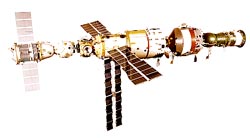DK Space: Space Stations
In a space station, a large crewed spacecraft orbiting Earth, astronauts can live and work in space for long periods. The INTERNATIONAL SPACE STATION (ISS) is the biggest structure ever to be built in space.
Astronauts carry out research in space stations. They examine the behavior of materials and living things in a microgravity (near-weightless) environment. They also study the effect of space flight on the human body.
Early space stations such as Russia’s Salyuts and the US Skylab were built on Earth and launched into orbit as complete units. Larger stations such as Mir and the ISS are assembled in orbit from modules (sections) that are ferried up from Earth one at a time.
Currently being built from more than 100 separate main parts, the ISS will be a global research center in space. The United States, through the National Aeronautics and Space Administration (NASA), provides most of the station hardware and is in charge of construction. Russia, Europe (through the European Space Agency), Japan, and Canada also supply major units.
The living and work space on the ISS is the same size as the passenger space on two 747 aircraft. There are four laboratory modules where astronauts carry out scientific research. The main living accommodation, for a crew of seven, is in the US habitation module. It has two decks and contains sleep stations, galley (kitchen), medical facility, gym, toilet, and shower in a space about 26 ft (8 m) long and 13 ft (4 m) wide.
Robots on the shuttle and the ISS connect new sections of the station, but spacewalking astronauts are needed to complete the job. More than 850 hours of extravehicular activity (EVA) will be required before assembly of the station is complete. Afterward, astronauts will have to make regular EVAs to carry out maintenance and repairs.

